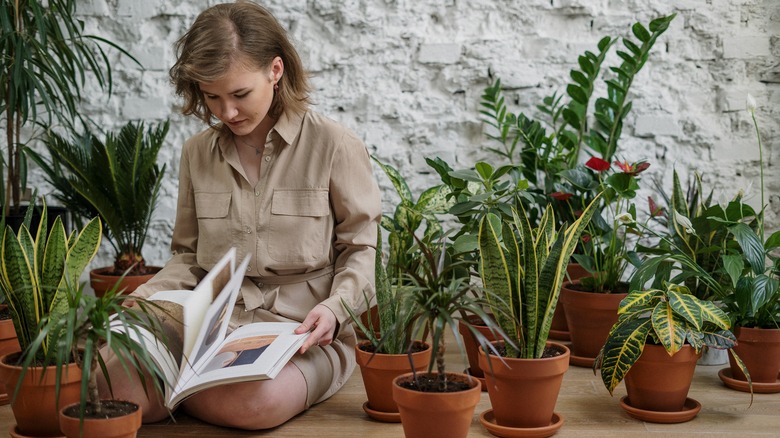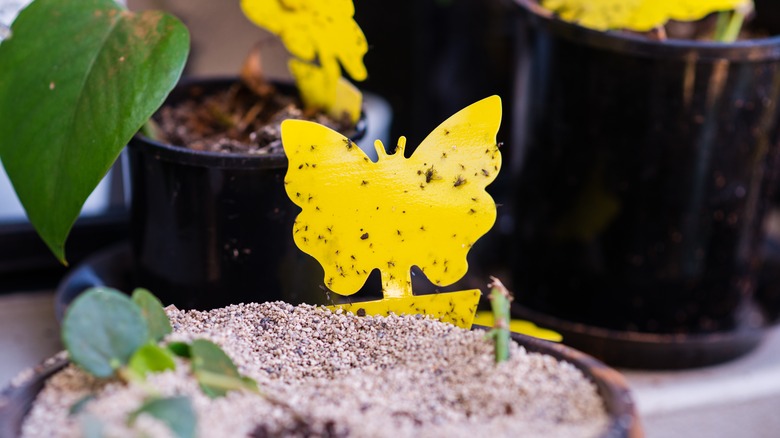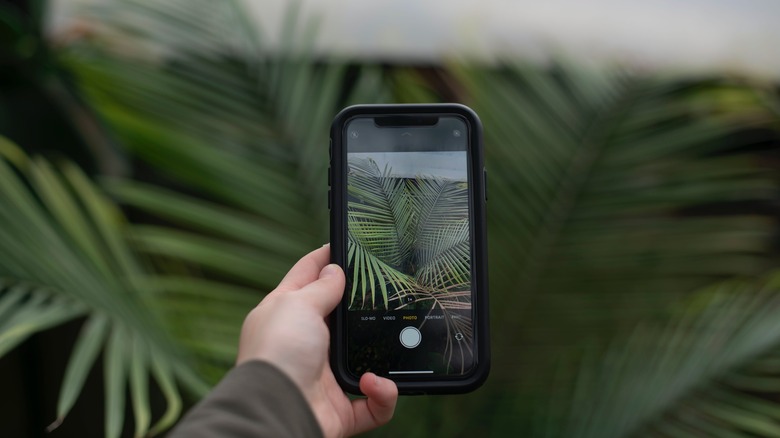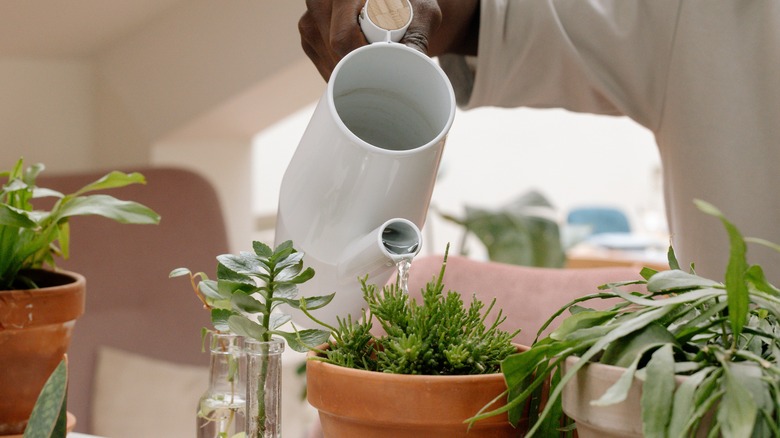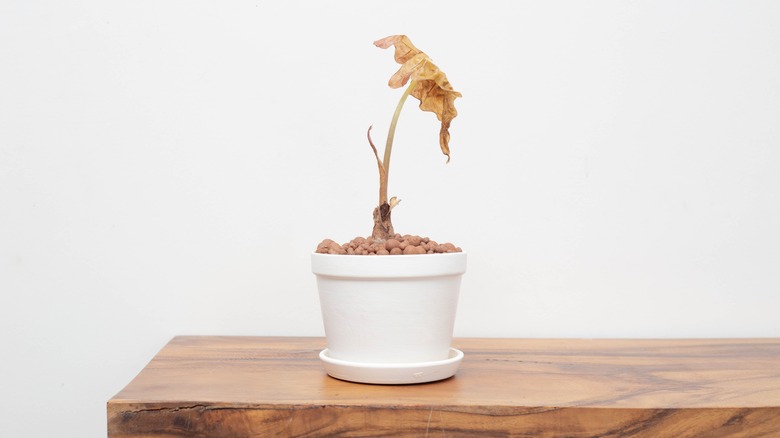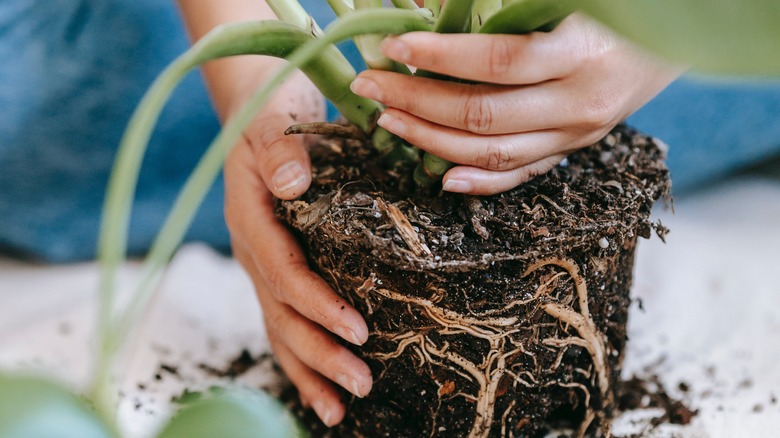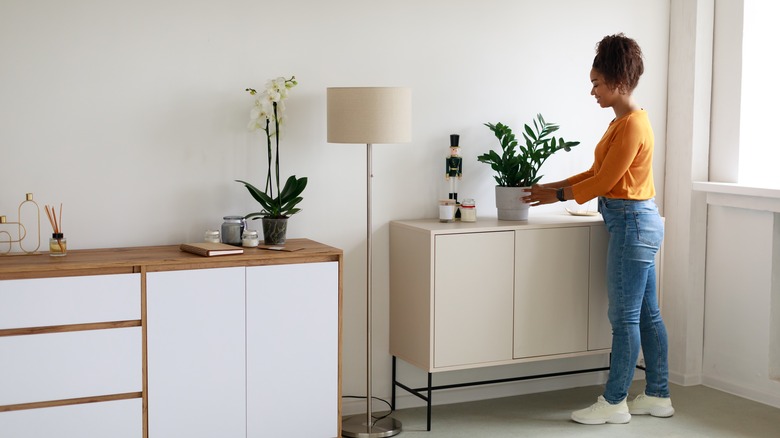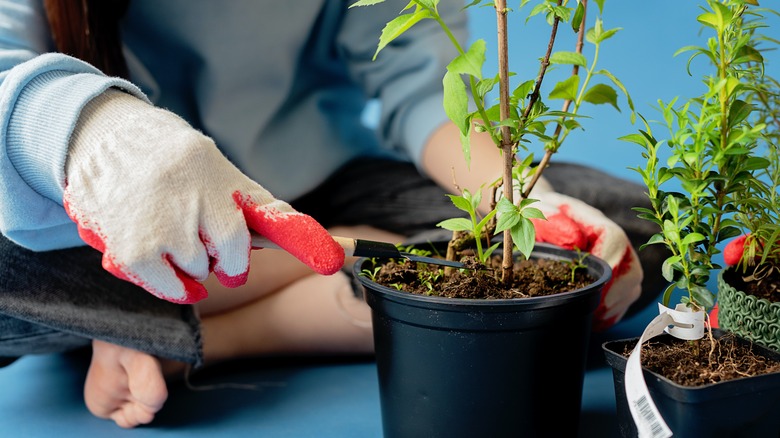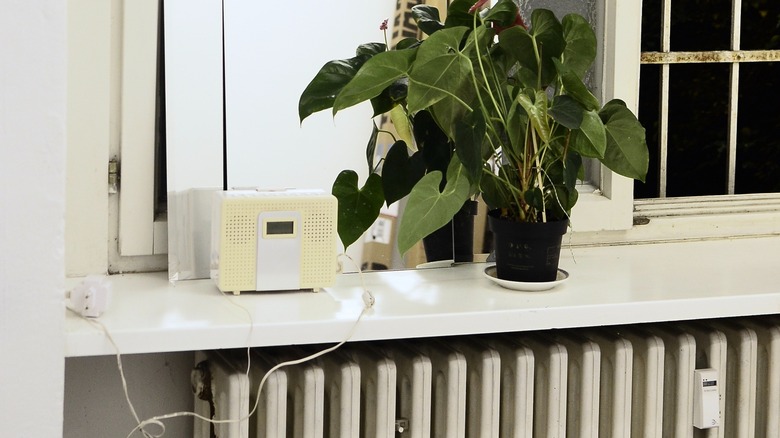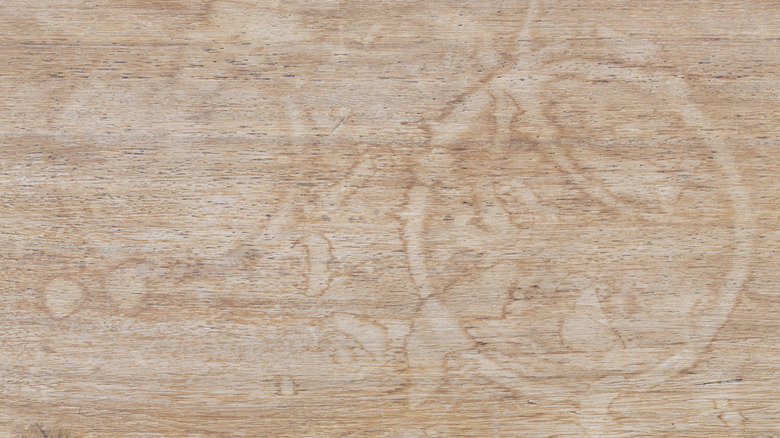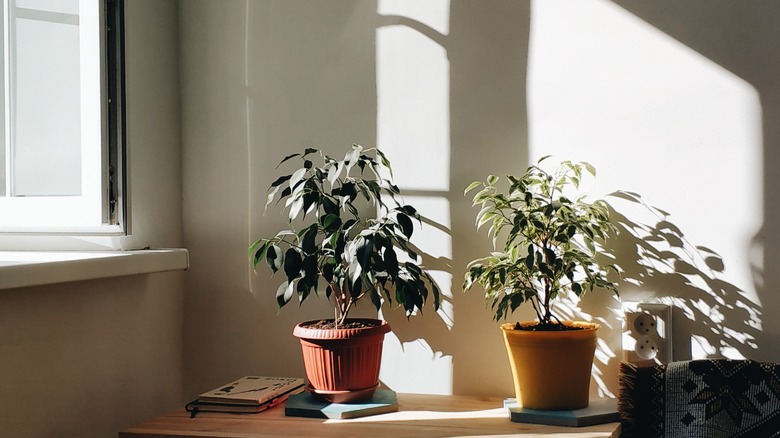Stop Making These Common Indoor Gardening Mistakes, For Your Plants' Sake
We may receive a commission on purchases made from links.
Potted plants, hanging planters, succulent walls, and countertop herb gardens are just a few of the big and small ways to bring a little greenery into your life that has gained traction over the past few years. Indoor gardens or the trend of plant moms and plant parenthood have become popular, especially among millennials in the wake of the pandemic. Yet the concept of houseplants and indoor gardens can be traced way back, all the way to ancient Greece and Rome, according to Medium. Many people today live in apartments. We don't all have patios, and most do not have the time and money to invest in a big outdoor garden. We're bringing the outside in with our indoor gardens! The question is, how do we do that without breaking the bank, killing all of our plant babies, and causing more of a headache?
Indoor gardens do not have to be all-consuming or financial burdens. A little greenery in your home has been proven to benefit your mood and body (via NBC News). Not only are plants nice to look at but they are great for improving air quality, regulating the humidity, and giving us a sense of purpose. For whatever reason you've chosen to add a couple or a hundred potted plants, there are more than a few common mistakes that can derail you. Try these tricks and beware of these bad habits to keep you and your plants happy.
Attracting fungus gnats
Bringing the outdoors in does not mean that you want to attract all of the little critters, creepy crawlies, and buzzing annoyances into your sanctuary. One of the most common issues that indoor plant owners struggle and battle with is the dreaded fungus gnats, according to Los Angeles Times. What exactly are fungus gnats? If you've noticed a small, very annoying insect that hovers around your plants, flies into your face, and seems to fly a little slower than a mosquito or a fruit fly, you probably have fungus gnats.
If there are plants or soil around, then fungus gnats can appear. These little critters aren't harmful to people except for annoying them. However, they can lay eggs, multiply like crazy, and the larvae, if there are enough of them, can do some damage to your plant's roots, which can cause your plants to stop growing or weaken (via University of California Agriculture & Nature Resources).
The worst part is that you can unknowingly bring them into your home anytime. You can bring them in from the outside or invite an infestation when you buy a new plant. Proven methods to fight them include stocking up on simple sticky traps that can go in or near your plants. They will catch the grown insects in their glue. But that's just the first step. Gnats can be attracted to damp soil, so watering from the bottom and covering the top of your soil with sand can help make the soil difficult for the bugs to get to. The final step to handle the larvae is to purchase beneficial nematodes, which you soak in water and then use to water your plants. One application should significantly help, but you can do this approximately every two weeks if necessary. These steps will attack the bugs at all stages of their life.
Trimming your plants instead of identifying the problem
You've done it. You've hopped on the bandwagon, and hanging planters, succulents, and cacti are taking over your home from floor to ceiling. Your thumbs are officially green. But buying up the plants in the cutest containers at Trader Joe's is only the beginning of this indoor gardening journey. According to APS Publications, gardening and plant care have long been a delicate science and practice. It requires knowledge and perseverance. If you're not committed to learning how to care for your plants properly, you may be in for a long, expensive, and a little bit sad road. Nothing is more satisfying than seeing your plants flourish, but each type requires a unique set of growing conditions and care instructions — not all plants can be treated the same way.
One common mistake among new plant owners is to notice a dead or dying leaf, get overly panicked, grab those shiny pruning scissors and start hacking away. The process will probably be more delicate than hacking, but the notion of trimming before identifying the problem is just as brutal.
Most diseases or issues with a plant can be determined by appearances. However, if you cut away the problem or misidentify the issue, you could be left with a dead plant faster than you can make another trip to Trader Joe's. Everything from brown leaves to drooping stems can signal a problem, such as over-watering, diseases, temperature problems, and more. PictureThis, PlantSnap, NatureID, and Blossom are just a few examples of smartphone apps that allow you to take a picture of plants and their leaves to identify the exact species or the infected area, according to the App Store. With this information, you can delve deeper into your research and discover the real issue.
Not organizing or labeling your plants to keep track of watering
Overwatering your plants or underwatering them is one of the surest ways to get your new garden into trouble. These common practices can lead to brown and yellow leaves, rotting roots, insect infestations, and more. The first step to watering properly is identifying your exact plant species. But there are other factors to consider, such as the container size, the lighting, and the humidity, according to HappySprout.
On top of that, there are different types of watering. Two typical methods are the soak-and-dry method and misting. Soak and dry is when you drench the soil thoroughly and allow enough time to pass until the top inch or so of the soil is dry to the touch. Then you repeat the process. Plants that thrive in high humidity appreciate misting, which can be daily or less frequently from a spray bottle or plant mister.
A watering schedule and labeling your plants can take the guesswork out of watering. You should start by identifying your plants and their watering needs. Separate them into categories such as once per week, once every other week, misting daily, and soak-and-dry. You could then use markers that stick in the soil, or labels on each pot or shelf, to help you easily recognize which plants need what. Watering on the same day each week is a helpful way to remember watering, or you can even create a calendar to stay extra organized. The most important point is to recognize your individual plants and water them routinely according to their needs.
Under-saturating the root systems
Once again, watering is one of the most common struggles regarding indoor gardens. Bottom watering is a great and effective way to water your indoor plants and saturate their roots, which can strengthen your plants overall. According to Sprouts and Stems, this method is used when your planter has good drainage and sits in a shallow bowl or plate. You pour water into the bowl, and the plant's root systems draw the water up to the plant. Start slowly and periodically check after watering for the first time to see how much water you'll need to get the soil damp throughout the pot. If you notice your plant is sitting in water the next day, toss the excess water and use a little less next time. This method has many benefits, including watering your plants more evenly and strengthening the roots in your potted plants because they have to work to get their water.
Another time when bottom watering and saturating roots are important is when you're transplanting to another pot. Before transplanting, you should prep your roots with extra water; then, when removing the plant, remember to soak the root ball and new hole (via eGardenGo). Saturating the roots will help the plant adjust and give the roots a break as they acclimate.
Not transplanting sooner
Transplanting is when the need to nurture comes in handy. According to PennState Extension, you should consider repotting your plant when the roots are strongly established and maybe even visible in the drainage holes, or if the plant becomes too big for the pot. For example, if the roots are visible and the plant wants to tip over, or if the plant has stayed the same size for a long time, you should consider finding a larger home or separating the plants into more than one container. You may also want to consider transplanting if you find it hard to keep up with watering and notice the soil drying out quickly.
Transplanting can keep your plant healthy, allow it to grow bigger, and even give it more space to produce sprouts that can be germinated and transplanted. According to Good Earth Plants, indoor plants likely need to be transplanted every 12 to 18 months if it is steadily growing.
Not using fertilizer
Having plants inside your home can be great, but it's important to remember that they are not naturally made for the indoors and may require different fertilizers inside to stay healthy. Fertilizer is often necessary for indoor plants, not to make them grow and grow and grow, but to keep them strong in low light. Inside there are no naturally-occurring fertilizers, and plants often produce less food in lower light, which means they will likely need a little help, according to Plant Care Today.
The important thing to remember is that most plants do not need a lot of fertilizer — unless the goal is to increase the size of your plant — and may need to be applied infrequently, according to the University of Maryland Extension. The various types of fertilizer, including slow-release fertilizers, make it easy to add just what's needed to your potted plants. There's no need to replace all the soil or transplant every time your green friend needs a boost.
Here are a few things to remember when fertilizing. Each plant is different. Do your research before making any expensive purchases, and pay close attention to what your plant needs based on its appearance. Too much fertilizing often results in long, limp stems and branches, but it can also damage your plant. If you notice a buildup of salt, then you are probably overfertilizing.
Forgetting to prune
Pruning is not just for plants that are outgrowing their pots or taking up too much space. There are many benefits of pruning to know about. According to HappySprout, there are specific times during the year to prune your plant, different ways to prune, and a few common mistakes to avoid.
The most important thing to remember about pruning is to do it during the active growing season. This is usually in the spring or summer, but can vary since the temperature changes are not as drastic indoors. If you notice your plant sprouting some new growth or looking extra green, it's probably in its active growing season. It may seem silly to prune away new growth, but this can stop your plant from outgrowing its pot, and it can create a fuller, more rounded plant rather than a tall and stringy one. Prune where the new growth separates from the stem and below the leaf. You can save these cuttings to try and repopulate, or simply discard them.
Putting tropical plants near heaters, A.C. units, or windows
Throughout the season, you may have to move your plants around your home to ensure the best environment for them, according to Clever. If there are fewer hours of sunlight, you may need to move it closer to direct sunlight. However, there's a common misconception that you should avoid, and your plant will thank you for it. Your radiators, air conditioning units, and heating and cooling vents can be the right place for your plant some of the time, but not necessarily all of the time.
If your plant requires a warm, humid environment, you may think the radiator will keep it toasty, but the dry air might kill it just as fast as a stiff breeze. The same goes for vents and A.C. units. The temperature might seem right, but sudden bursts and changes to the temperate are wrong for houseplants.
Even your tropical plants don't need a blast of hot, dry air followed by a steady stream of lukewarm air. The best tactic is to know what your plant needs and keep it consistent. If your plant thrives in humidity, the bathroom may be a better place for it if there's good lighting. Additionally, watering may not have to be on such a tight schedule in the peak summer and winter months because of your heating and cooling units. Test the soil for dampness with your hands if the temperatures are hitting highs and lows that seem to upset your plants. Pay close attention to how dry the leaves are and if they're straining towards the light.
Not protecting your shelves, tables, and floors with water trays
If you've joined the community of plant lovers, then you likely were hoping to bring a little fun and freshness into your apartment or home. But plants are made for the outside, and they can wreak havoc on your interiors if you aren't careful. Consider adding shelf protectors that are plastic and available on Amazon to make wiping up stray water easy. If you spill water or it leaks out of the bottom of your plant, you could easily end up with an unsightly watermark or stain on your shelves, tables, and floors. In addition, Amazon offers decorative pot mats that go under your planters to maintain the area around your plants neatly.
Finally, a small handheld vacuum or tiny attachment for your regular vacuum will be great for sucking up stray dirt that's made its way out of your pots. You can easily go around planters and keep the area clean. For even more convenience, a small dustpan and brush will also make clean-up easy. Have these items on hand, and your plants will thrive without the mess.
Misunderstanding the light that your indoor plants need
The truth is, sometimes, over-simplified plant care instructions can be downright confusing. For example, what exactly is medium light? Is across the room from wall-to-ceiling windows considered medium, or is next to the windows where your plant needs to be? It can all be a little vague. The best tip is to identify your plant and research precisely what it needs. Websites and Farmers' Almanac can be much more detailed about care instructions than seed packets.
According to Savvy Gardening, the simple mistake of misunderstanding your plant's needs can lead to big disappointment in your indoor garden. Most indoor plants need bright indirect light, but there are other types of light to consider. Direct sun is just what it sounds like — it's directly in the sun. The light is intense, and you'll notice that your tropical plants may wilt if they're in it for more than a few hours. Filtered light is partially blocked by something, and sky light means they might not get direct sun all day, but they are in view of the sky and not blocked by anything.
If you are really struggling, trial and error is a good method. Just be sure to keep careful watch over your plant while you're assessing, and don't make any other changes with temperature or watering in the meantime. Some plant enthusiasts go as far as using a light meter, but that isn't necessary.
